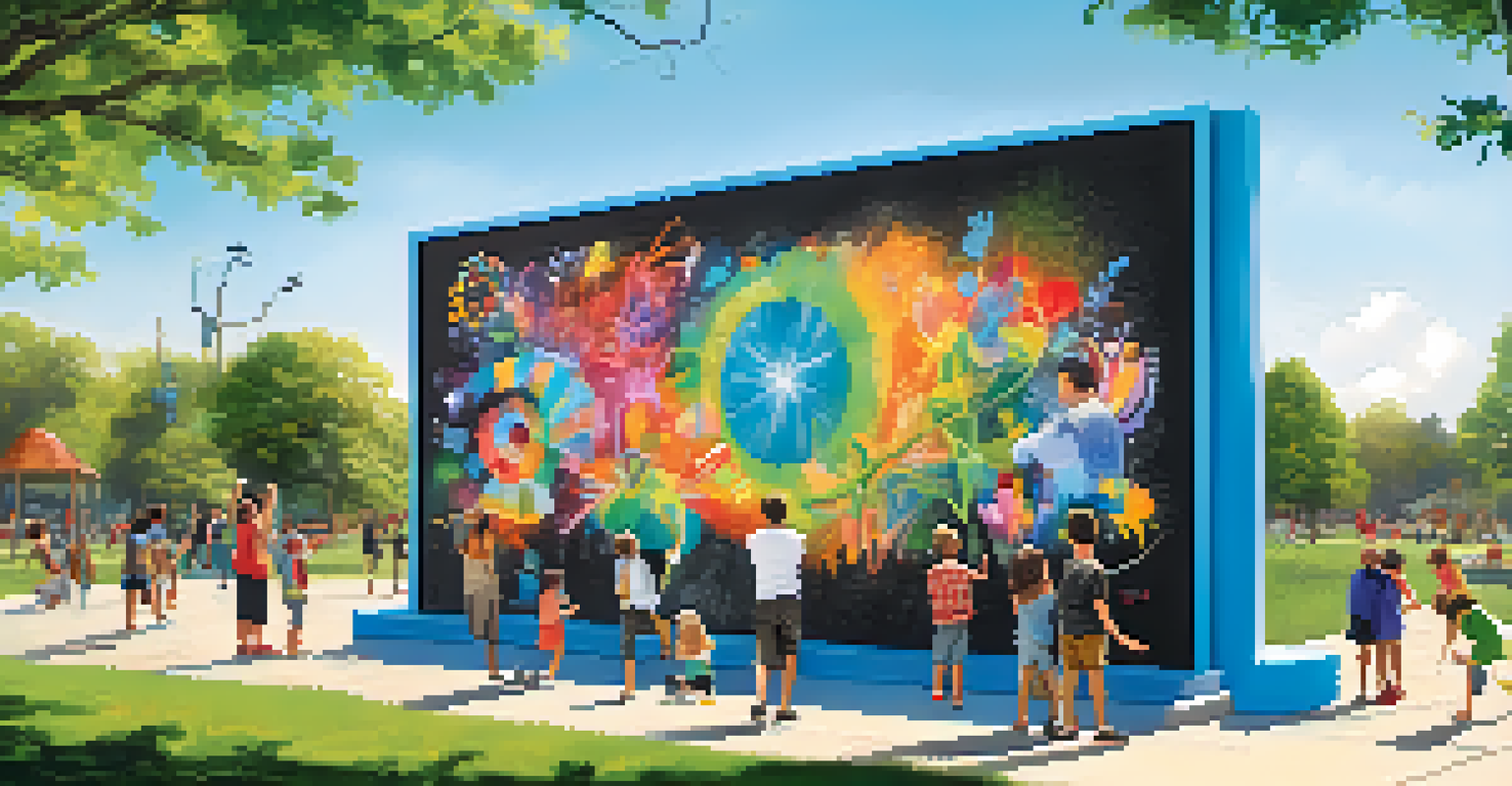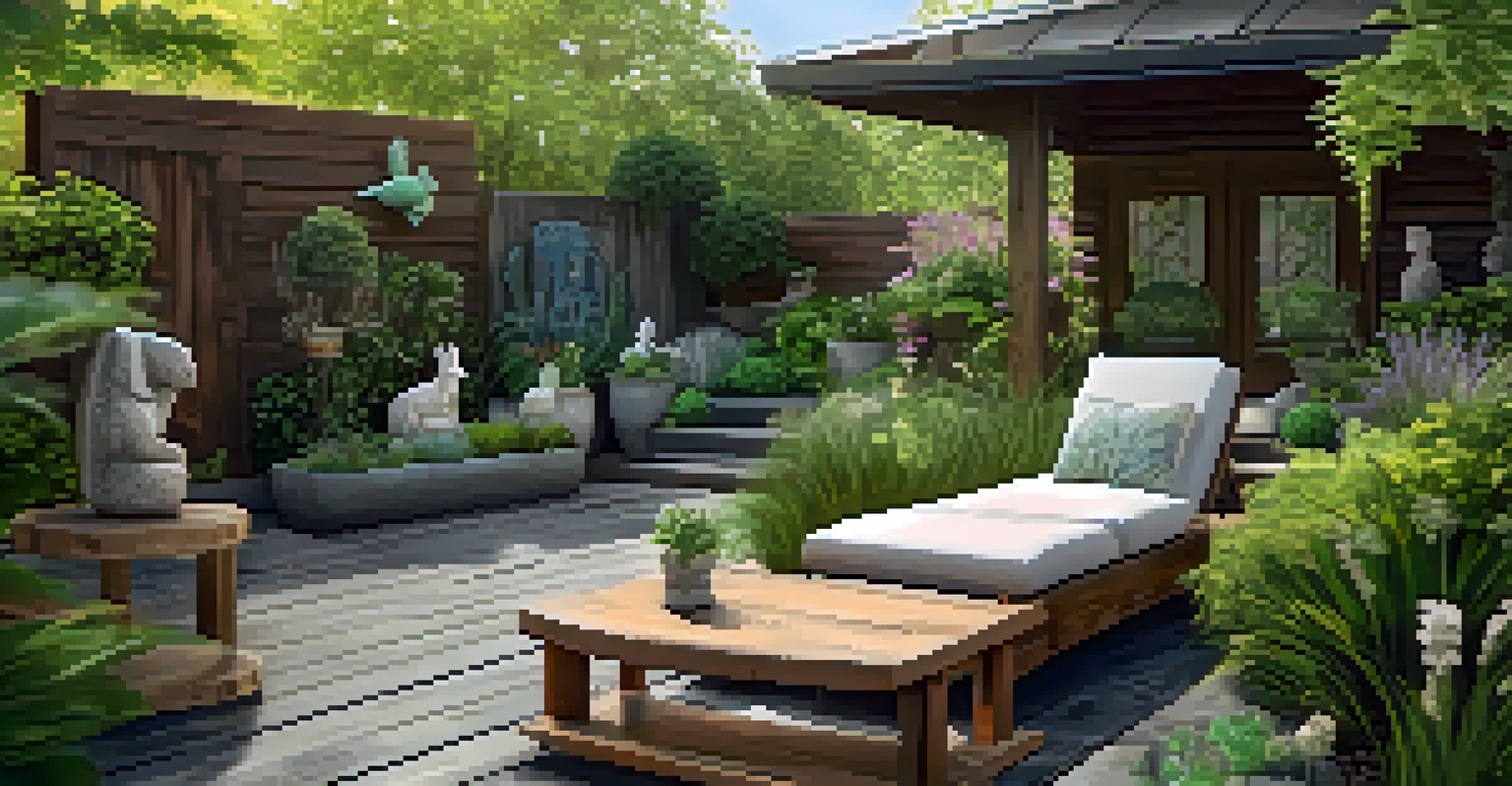Art in Outdoor Spaces: Trending Decorative Ideas

The Rise of Outdoor Art Installations
In recent years, outdoor art installations have gained immense popularity, transforming gardens and parks into vibrant galleries. Artists are now using natural settings as backdrops, creating pieces that interact with the environment. These installations not only beautify spaces but also invite community engagement, making art accessible to everyone.
Art is not what you see, but what you make others see.
Think about how a large sculpture can serve as a focal point in a garden, drawing visitors in and sparking conversations. For example, a colorful mosaic bench can provide both seating and artistic flair, blending functionality with creativity. As these installations continue to trend, they inspire homeowners and cities alike to rethink how they showcase art in public spaces.
Ultimately, outdoor art installations encourage us to appreciate our surroundings in new ways. They can highlight the beauty of nature while also reflecting cultural narratives or social issues. As we embrace this trend, we create spaces that inspire connection, imagination, and exploration.
Incorporating Nature into Art
One of the most fascinating trends in outdoor art is the incorporation of natural elements. Artists are increasingly using materials like wood, stone, and metal that not only complement but also enhance their surroundings. This approach creates a sense of harmony, allowing the artwork to feel like a natural extension of the environment.

For instance, a wooden sculpture made from reclaimed timber can blend seamlessly with a forest backdrop, creating a striking visual experience. Similarly, stone installations can add texture and permanence to gardens, evoking a sense of stability. By using local materials, artists also promote sustainability and a deeper connection to the landscape.
Outdoor Art Enhances Community Spaces
Outdoor art installations transform public areas into vibrant, engaging environments that foster community interaction.
Moreover, nature-inspired art doesn’t just exist within the confines of traditional sculptures. It can include living installations, such as vertical gardens or plant sculptures, which evolve over time. This dynamic aspect of art keeps outdoor spaces fresh and engaging, encouraging people to return and witness the changes.
Functional Art: The Practical Side of Aesthetics
Functional art is taking the outdoor decor world by storm, merging beauty with usability. This trend encompasses items like artistic benches, decorative planters, and unique lighting fixtures that serve both aesthetic and practical purposes. By integrating art into everyday objects, we can enrich our outdoor experiences.
The earth without art is just 'eh'.
Imagine a beautifully designed birdhouse that not only provides shelter for feathered friends but also becomes a conversation starter in your garden. Or consider a sculptural fire pit that adds warmth and ambiance while enhancing the outdoor aesthetic. These elements make outdoor spaces more inviting and enjoyable for relaxing or entertaining.
The charm of functional art lies in its ability to serve a purpose while showcasing creativity. Homeowners are increasingly drawn to these unique pieces, which allow them to express their style and enhance their outdoor environments. As a result, functional art is not just a trend; it's a lasting shift in how we view and utilize our outdoor spaces.
Interactive Installations: Engaging the Community
Interactive art installations are becoming a favorite among artists and communities alike. These works invite participation, allowing viewers to engage with art in a hands-on way. This trend not only makes art more accessible but also fosters a sense of community as people come together to create and share experiences.
Consider a giant chalkboard wall in a park where children and adults can unleash their creativity. Such installations encourage free expression and can become a living canvas that evolves with each visitor. These interactive elements make art a shared journey, rather than a solitary experience, enhancing community bonds.
Sustainability in Art Practices
Artists are increasingly adopting eco-friendly materials and techniques, promoting environmental awareness through their work.
Moreover, interactive installations often lead to events, workshops, and gatherings, further enriching community life. By incorporating these engaging pieces into outdoor spaces, we can transform public areas into lively hubs of creativity and connection. Ultimately, these installations remind us that art is not just to be admired—it’s meant to be experienced.
Sustainable Art Practices: Eco-Friendly Trends
With growing awareness of environmental issues, sustainable art practices are gaining traction in outdoor spaces. Artists are increasingly using recycled materials and eco-friendly techniques to create their masterpieces. This trend highlights the importance of sustainability while encouraging others to consider their environmental impact.
For instance, sculptures made from reclaimed metal or glass not only reduce waste but also tell a story of transformation and renewal. Similarly, artists might incorporate native plants into their installations, promoting biodiversity and ecological balance. This approach not only beautifies spaces but also fosters a deeper appreciation for nature.
By embracing sustainability, artists inspire communities to think critically about their consumption habits. These eco-friendly practices encourage a more responsible relationship with our environment, reminding us that art can play a vital role in advocating for change. As we support sustainable art, we contribute to a healthier planet for future generations.
The Power of Color in Outdoor Art
Color plays a pivotal role in outdoor art, influencing emotions and perceptions. Bright, bold hues can energize a space, while softer tones can create a calm and inviting atmosphere. Artists are utilizing color in innovative ways to enhance outdoor environments, captivating viewers and encouraging exploration.
Consider a vibrant mural on a blank wall that transforms an otherwise dull area into a lively focal point. Such colors can draw people in, creating a sense of joy and excitement. Similarly, colorful sculptures scattered throughout a garden can lead the eye and create a playful, whimsical experience.
Personalizing Outdoor Art Spaces
Homeowners are creating unique outdoor art spaces that reflect their individuality and foster creativity.
Moreover, the use of color can evoke memories and feelings, making art a powerful tool for connection. As communities embrace this trend, we see more public spaces adorned with art that speaks to the heart. Ultimately, the thoughtful application of color in outdoor art enriches our surroundings and nurtures our emotional well-being.
Creating Personal Outdoor Art Spaces
As outdoor art becomes more popular, many individuals are looking to create personal art spaces in their own gardens. This trend allows homeowners to express their unique style while curating an environment that brings them joy. From small sculptures to elaborate installations, the possibilities for personalization are endless.
Imagine designing a cozy nook with comfortable seating, surrounded by your favorite artworks and plants. This can become a sanctuary for relaxation and creativity, where you can unwind and appreciate your surroundings. By thoughtfully selecting pieces that resonate with you, your outdoor space can reflect your personality and values.

Creating a personal art space also encourages inspiration and creativity. It invites experimentation with new ideas, whether by changing out decor or incorporating seasonal elements. As we cultivate these spaces, we not only enhance our homes but also enrich our lives, fostering a deeper connection to the art we love.